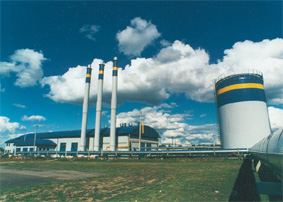
ENhanced Geothermal
Innovative Network
for Europe
LITHUANIA
Klaipėda Geothermal District Heating Station
Institute of Geology & Geography
- Project Name: Klaipėda Geothermal Demonstration Plant
- Project Leader [Companies]: UAB Geoterma
- Contact Person: Alfonsas Bickus (director)
- Country: Lithuania
- Location: Klaipėda
- Types of resource [High/Low Enthalpy / EGS etc.]: Low Enthalpy
- Main on-site operators [Drilling, Simulation, Monitoring, Power plant etc.]: UAB Geoterma
- Number of wells [w. Total Depth pr. well]: 4 wells, depths 1128-1228 m
- Type of wells [Exploration, Production, Injection]: 2 production and 2 injection wells
- Well configuration [Single well, Doublet, Triplet]: single wells
- Distance between well at Depth [Horiz. Dist at Depth]: 3.5 km
- Temperature at Total Depth [Single well, Doublet, Triplet]: 38oC
- Combination with other energy sources [Biomass, Biogas plants etc.]: natural gas
- Geothermal co-operation [Heat, Electricity etc.]: heat
- Geothermal potential [MW at Date]: 18 MW
- Expected Installed capacity [MW/time at Date]: 18 MW geothermal+23MW from boilers
- Expected Running capacity [MW/time at Date]: 13.6 MW geothermal+23MW from boilers
Exploration History
- Reason: Demonstration of possibility of the utilisation of the low-enthalpy sources in the Baltic region
- Dates: 1997 – beginning of the project, 2004 – commissioning of the geothermal plant. Now in operation.
- Geology: The Klaipeda plant is situated in the Baltic cratonic sedimentary basin comprising only weakly tectonized sediments of Late Vendian to Quaternary age. In west Lithuania, where Klaipeda City is located, the geothermal anomaly is identified where the heat flow attains 70-90 mW/m2, against the background values of 30-40 mW/m2. The thickness of sedimentary cover in west Lithuania is about 2 km. It comprises several regional-scale geothermal aquifers. The upper Lower Devonian aquifer was identified as the target for the Klaipeda Geothermal Plant. The depth of top of the formation is 990 m, the bottom depth is 1118 m. Some lithological variations are recognised in the site area that have an impact on the reservoir properties. Some small scale tectonic features are identified by seismic survey.
- Project funding: The Danish Environmental Protection Agency, the Government of Lithuania and the World Bank (IBRD) (loan 5.9USD million) have contributed to the establishment of the financial package required for the construction of the plant. Further EU PHARE and Global Environmental Facility Trust Fund granted money for the project. Total budget - 19.5 million USD.
- Distribution network: Klaipeda Plant is connected to central hot water supply network of Klaipeda city (187 000 population).
Reservoir Characteristics
- Type of reservoir [fractured, porous or both] Porous
- Hosted lithology/rock/mineralogy/fluids [composition] Lower Devonian sandstone, quartzouse with varrying amount of feldspar, mainly fine-grained, intercalates with siltstone and shale amounting 30% of aquifer, TDS of formation water 93 g/l, Na-Cl type, 160 ml gas dissolved in 1 l water.
- Fracture system Not important
- Stress field Shmax direction NNE-SSW
- Temperature range 38oC
- Main reservoir characteristics Total thickness 128 m, net-to-gross 0.7, the average porosity of sandstones 25%, the average permeability 2.6 d.
- Connectivity between wells Good
- Flow rate 300-400 m3/h, the formation infectivity is somewhat lower
Exploitation
- Type of exploitation/power plant single flush
- Type of secondary fluid Li Br
- Production quail ability [day/year] 1 year
- Injection fluid reinjected formation water
- Need for special tools AHP
- Development/improvement of methods inhibitors
On-going and future works planes
The injection of the formation water back into the Lower Devonian aquifer is highly problematic due to formation damage during drilling. It is therefore necessary to perform hydrofracturing experiment in the future to increase formation capacity.
Main References
Radeckas B., Lukosevicius V. (2000). Klaipeda Geothermal Demonstration Project. In: Proceedings Word Geothermal Congress 2000. Kyushu-Tohoku, Japan, May 28 - June 10. 2000. p. 3547-3550.
Zinevicius F, Bickus A., Rasteniene V., Suveizdis P. (2005) Inauguration of first geothermal plant in Lithuania. IGA News #59, January-March 2005.

View of Klaipeda Geothermal Demonstration Plant






